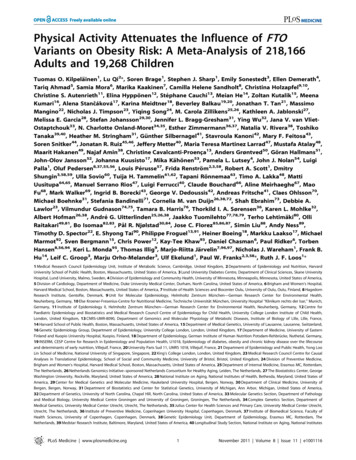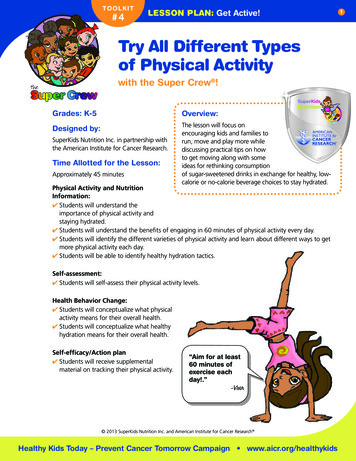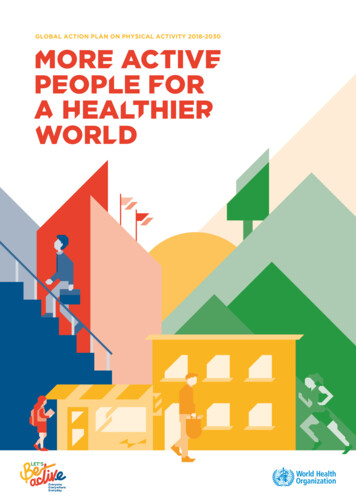
Transcription
Physical Activity Attenuates the Influence of FTOVariants on Obesity Risk: A Meta-Analysis of 218,166Adults and 19,268 ChildrenTuomas O. Kilpeläinen1, Lu Qi2*, Soren Brage1, Stephen J. Sharp1, Emily Sonestedt3, Ellen Demerath4,Tariq Ahmad5, Samia Mora6, Marika Kaakinen7, Camilla Helene Sandholt8, Christina Holzapfel9,10,Christine S. Autenrieth11, Elina Hyppönen12, Stéphane Cauchi13, Meian He14, Zoltan Kutalik15, MeenaKumari16, Alena Stančáková17, Karina Meidtner18, Beverley Balkau19,20, Jonathan T. Tan21, MassimoMangino22, Nicholas J. Timpson23, Yiqing Song24, M. Carola Zillikens25,26, Kathleen A. Jablonski27,Melissa E. Garcia28, Stefan Johansson29,30, Jennifer L. Bragg-Gresham31, Ying Wu32, Jana V. van VlietOstaptchouk33, N. Charlotte Onland-Moret34,35, Esther Zimmermann36,37, Natalia V. Rivera38, ToshikoTanaka39,40, Heather M. Stringham31, Günther Silbernagel41, Stavroula Kanoni42, Mary F. Feitosa43,Soren Snitker44, Jonatan R. Ruiz45,46, Jeffery Metter40, Maria Teresa Martinez Larrad47, Mustafa Atalay48,Maarit Hakanen49, Najaf Amin38, Christine Cavalcanti-Proença13, Anders Grøntved50, Göran Hallmans51,John-Olov Jansson52, Johanna Kuusisto17, Mika Kähönen53, Pamela L. Lutsey4, John J. Nolan54, LuigiPalla1, Oluf Pedersen8,37,55,56, Louis Pérusse57, Frida Renström2,3,58, Robert A. Scott1, DmitryShungin3,58,59, Ulla Sovio60, Tuija H. Tammelin61,62, Tapani Rönnemaa63, Timo A. Lakka48, MattiUusitupa64,65, Manuel Serrano Rios47, Luigi Ferrucci40, Claude Bouchard66, Aline Meirhaeghe67, MaoFu68, Mark Walker69, Ingrid B. Borecki43, George V. Dedoussis42, Andreas Fritsche41, Claes Ohlsson70,Michael Boehnke31, Stefania Bandinelli71, Cornelia M. van Duijn26,38,72, Shah Ebrahim73, Debbie A.Lawlor23, Vilmundur Gudnason74,75, Tamara B. Harris76, Thorkild I. A. Sørensen36, Karen L. Mohlke32,Albert Hofman26,38, André G. Uitterlinden25,26,38, Jaakko Tuomilehto77,78,79, Terho Lehtimäki80, OlliRaitakari49,81, Bo Isomaa82,83, Pål R. Njølstad30,84, Jose C. Florez85,86,87, Simin Liu88, Andy Ness89,Timothy D. Spector22, E. Shyong Tai90, Philippe Froguel13,91, Heiner Boeing18, Markku Laakso17, MichaelMarmot92, Sven Bergmann15, Chris Power12, Kay-Tee Khaw93, Daniel Chasman6, Paul Ridker6, TorbenHansen8,56,94, Keri L. Monda95, Thomas Illig9, Marjo-Riitta Järvelin7,96,97, Nicholas J. Wareham1, Frank B.Hu14, Leif C. Groop3, Marju Orho-Melander3, Ulf Ekelund1, Paul W. Franks2,3,58*, Ruth J. F. Loos1*1 Medical Research Council Epidemiology Unit, Institute of Metabolic Science, Cambridge, United Kingdom, 2 Departments of Epidemiology and Nutrition, HarvardUniversity School of Public Health, Boston, Massachusetts, United States of America, 3 Lund University Diabetes Centre, Department of Clinical Sciences, Skane UniversityHospital, Lund University, Malmo, Sweden, 4 Division of Epidemiology and Community Health, University of Minnesota, Minneapolis, Minnesota, United States of America,5 Division of Cardiology, Department of Medicine, Duke University Medical Center, Durham, North Carolina, United States of America, 6 Brigham and Women’s Hospital,Harvard Medical School, Boston, Massachusetts, United States of America, 7 Institute of Health Sciences and Biocenter Oulu, University of Oulu, Oulu, Finland, 8 HagedornResearch Institute, Gentofte, Denmark, 9 Unit for Molecular Epidemiology, Helmholtz Zentrum München—German Research Center for Environmental Health,Neuherberg, Germany, 10 Else Kroener-Fresenius-Centre for Nutritional Medicine, Technische Universität München, University Hospital ‘‘Klinikum rechts der Isar,’’ Munich,Germany, 11 Institute of Epidemiology II, Helmholtz Zentrum München—German Research Center for Environmental Health, Neuherberg, Germany, 12 Centre forPaediatric Epidemiology and Biostatistics and Medical Research Council Centre of Epidemiology for Child Health, University College London Institute of Child Health,London, United Kingdom, 13 CNRS-UMR-8090, Department of Genomics and Molecular Physiology of Metabolic Diseases, Institute of Biology of Lille, Lille, France,14 Harvard School of Public Health, Boston, Massachusetts, United States of America, 15 Department of Medical Genetics, University of Lausanne, Lausanne, Switzerland,16 Genetic Epidemiology Group, Department of Epidemiology, University College London, London, United Kingdom, 17 Department of Medicine, University of EasternFinland and Kuopio University Hospital, Kuopio, Finland, 18 Department of Epidemiology, German Institute of Human Nutrition Potsdam-Rehbrücke, Nuthetal, Germany,19 INSERM, CESP Centre for Research in Epidemiology and Population Health, U1018, Epidemiology of diabetes, obesity and chronic kidney disease over the lifecourseand determinants of early nutrition, Villejuif, France, 20 University Paris Sud 11, UMRS 1018, Villejuif, France, 21 Department of Epidemiology and Public Health, Yong LooLin School of Medicine, National University of Singapore, Singapore, 22 King’s College London, London, United Kingdom, 23 Medical Research Council Centre for CausalAnalyses in Translational Epidemiology, School of Social and Community Medicine, University of Bristol, Bristol, United Kingdom, 24 Division of Preventive Medicine,Brigham and Women’s Hospital, Harvard Medical School, Boston, Massachusetts, United States of America, 25 Department of Internal Medicine, Erasmus MC, Rotterdam,The Netherlands, 26 Netherlands Genomics Initiative–sponsored Netherlands Consortium for Healthy Aging, Leiden, The Netherlands, 27 The Biostatistics Center, GeorgeWashington University, Rockville, Maryland, United States of America, 28 National Institute on Aging, National Institutes of Health, Bethesda, Maryland, United States ofAmerica, 29 Center for Medical Genetics and Molecular Medicine, Haukeland University Hospital, Bergen, Norway, 30 Department of Clinical Medicine, University ofBergen, Bergen, Norway, 31 Department of Biostatistics and Center for Statistical Genetics, University of Michigan, Ann Arbor, Michigan, United States of America,32 Department of Genetics, University of North Carolina, Chapel Hill, North Carolina, United States of America, 33 Molecular Genetics Section, Department of Pathologyand Medical Biology, University Medical Centre Groningen and University of Groningen, Groningen, The Netherlands, 34 Complex Genetics Section, Department ofMedical Genetics, University Medical Center Utrecht, Utrecht, The Netherlands, 35 Julius Center for Health Sciences and Primary Care, University Medical Center Utrecht,Utrecht, The Netherlands, 36 Institute of Preventive Medicine, Copenhagen University Hospital, Copenhagen, Denmark, 37 Institute of Biomedical Science, Faculty ofHealth Sciences, University of Copenhagen, Copenhagen, Denmark, 38 Genetic Epidemiology Unit, Department of Epidemiology, Erasmus MC, Rotterdam, TheNetherlands, 39 Medstar Research Institute, Baltimore, Maryland, United States of America, 40 Longitudinal Study Section, National Institute on Aging, National InstitutesPLoS Medicine www.plosmedicine.org1November 2011 Volume 8 Issue 11 e1001116
Physical Activity Attenuates Influence of FTOof Health, Baltimore, Maryland, United States of America, 41 Department of Internal Medicine, Division of Endocrinology, Diabetology, Nephrology, Vascular Disease, andClinical Chemistry, Eberhard-Karls-University Tübingen, Tübingen, Germany, 42 Department of Nutrition-Dietetics, Harokopio University of Athens, Athens, Greece,43 Division of Statistical Genomics, Washington University School of Medicine, St. Louis, Missouri, United States of America, 44 University of Maryland School of Medicine,College Park, Maryland, United States of America, 45 Unit for Preventive Nutrition, Department of Biosciences and Nutrition at NOVUM, Karolinska Institutet, Huddinge,Sweden, 46 Department of Physical Education and Sport, School of Physical Activity and Sport Sciences, University of Granada, Granada, Spain, 47 Centro de InvestigaciónBiomédica en Red de Diabetes y Enfermedades Metabólicas Asociadas, Hospital Clı́nico San Carlos, Madrid, Spain, 48 Institute of Biomedicine, Department of Physiology,University of Eastern Finland, Kuopio Campus, Kuopio, Finland, 49 The Research Centre of Applied and Preventive Cardiovascular Medicine, University of Turku, Turku,Finland, 50 Institute of Sport Science and Clinical Biomechanics, University of Southern Denmark, Odense, Denmark, 51 Department of Public Health and Clinical MedicineSection for Nutritional Research, Umeå University, Umeå, Sweden, 52 Department of Physiology, Institute of Neuroscience and Physiology, Sahlgrenska Academy,University of Gothenburg, Gothenburg, Sweden, 53 Department of Clinical Physiology, University of Tampere and Tampere University Hospital, Tampere, Finland,54 Steno Diabetes Centre, Gentofte, Denmark, 55 Faculty of Health Sciences, University of Aarhus, Aarhus, Denmark, 56 Marie Krogh Center for Metabolic Research,Faculty of Health Sciences, University of Copenhagen, Copenhagen, Denmark, 57 Division of Kinesiology, Department of Social and Preventive Medicine, Laval University,Ste-Foy, Quebec, Canada, 58 Genetic Epidemiology and Clinical Research Group, Department of Public Health and Clinical Medicine, Section for Medicine, UmeåUniversity Hospital, Umeå, Sweden, 59 Department of Odontology, Umeå University, Umeå, Sweden, 60 Department of Medical Statistics, London School of Hygiene andTropical Medicine, London, United Kingdom, 61 Finnish Institute of Occupational Health, Oulu, Finland, 62 LIKES Research Center for Sport and Health Sciences, Jyväskylä,Finland, 63 Department of Medicine, University of Turku, Turku, Finland, 64 Institute of Public Health and Clinical Nutrition, University of Eastern Finland, Kuopio Campus,Kuopio, Finland, 65 Research Unit, Kuopio University Hospital, Kuopio, Finland, 66 Human Genomics Laboratory, Pennington Biomedical Research Center, Baton Rouge,Louisiana, United States of America, 67 INSERM, U744, Institut Pasteur de Lille, Université Lille Nord de France, Université Lille 2, Lille, France, 68 Division of Endocrinology,Diabetes and Nutrition, University of Maryland School of Medicine, Baltimore, Maryland, United States of America, 69 Institute of Cell and Molecular Biosciences,Newcastle University, Newcastle, United Kingdom, 70 Centre for Bone and Arthritis Research, Department of Internal Medicine, Institute of Medicine, SahlgrenskaAcademy, University of Gothenburg, Gothenburg, Sweden, 71 Geriatric Rehabilitation Unit, Azienda Sanitaria Firenze, Florence, Italy, 72 Netherlands Genomics Initiative,Centre for Medical Systems Biology, Leiden, The Netherlands, 73 Faculty of Epidemiology and Population Health, London School of Hygiene and Tropical Medicine,London, United Kingdom, 74 Icelandic Heart Association, Heart Preventive Clinic and Research Institute, Kopavogur, Iceland, 75 University of Iceland, Reykjavik, Iceland,76 Intramural Research Program, National Institute on Aging, National Institutes of Health, Bethesda, Maryland, United States of America, 77 Hjelt Institute, Department ofPublic Health, University of Helsinki, Helsinki, Finland, 78 South Ostrobothnia Central Hospital, Seinäjoki, Finland, 79 Department of Clinical and Preventive Medicine,Danube-University Krems, Krems, Austria, 80 Department of Clinical Chemistry, University of Tampere and Tampere University Hospital, Tampere, Finland, 81 Departmentof Clinical Physiology, Turku University Hospital, Turku, Finland, 82 Folkhälsan Research Centre, Helsinki, Finland, 83 Department of Social Services and Health Care,Jakobstad, Finland, 84 Department of Pediatrics, Haukeland University Hospital, Bergen, Norway, 85 Center for Human Genetic Research and Diabetes Research Center,Massachusetts General Hospital, Boston, Massachusetts, United States of America, 86 Department of Medicine, Harvard Medical School, Boston, Massachusetts, UnitedStates of America, 87 Program for Medical and Population Genetics, Broad Institute, Cambridge, Massachusetts, United States of America, 88 Center for Metabolic DiseasePrevention, School of Public Health and David Geffen School of Medicine, University of California, Los Angeles, California, United States of America, 89 School of Oral andDental Sciences, University of Bristol, Bristol, United Kingdom, 90 Department of Medicine, Yong Loo Lin School of Medicine, National University of Singapore, Singapore,91 Centre and Department of Genomic Medicine, Hammersmith Hospital, Imperial College London, London, United Kingdom, 92 Department of Epidemiology and PublicHealth, University College London, London, United Kingdom, 93 Department of Public Health and Primary Care, Institute of Public Health, University of Cambridge,Cambridge, United Kingdom, 94 Faculty of Health Sciences, University of Southern Denmark, Odense, Denmark, 95 Department of Epidemiology, University of NorthCarolina, Chapel Hill, North Carolina, United States of America, 96 Department of Epidemiology and Biostatistics, Imperial College London, London, United Kingdom,97 Department of Life Course and Services, National Institute for Health and Welfare, Oulu, FinlandAbstractBackground: The FTO gene harbors the strongest known susceptibility locus for obesity. While many individual studies havesuggested that physical activity (PA) may attenuate the effect of FTO on obesity risk, other studies have not been able toconfirm this interaction. To confirm or refute unambiguously whether PA attenuates the association of FTO with obesity risk,we meta-analyzed data from 45 studies of adults (n 218,166) and nine studies of children and adolescents (n 19,268).Methods and Findings: All studies identified to have data on the FTO rs9939609 variant (or any proxy [r2.0.8]) and PA wereinvited to participate, regardless of ethnicity or age of the participants. PA was standardized by categorizing it into adichotomous variable (physically inactive versus active) in each study. Overall, 25% of adults and 13% of children werecategorized as inactive. Interaction analyses were performed within each study by including the FTO6PA interaction term inan additive model, adjusting for age and sex. Subsequently, random effects meta-analysis was used to pool the interactionterms. In adults, the minor (A2) allele of rs9939609 increased the odds of obesity by 1.23-fold/allele (95% CI 1.20–1.26), butPA attenuated this effect (pinteraction 0.001). More specifically, the minor allele of rs9939609 increased the odds of obesityless in the physically active group (odds ratio 1.22/allele, 95% CI 1.19–1.25) than in the inactive group (odds ratio 1.30/allele, 95% CI 1.24–1.36). No such interaction was found in children and adolescents.Conclusions: The association of the FTO risk allele with the odds of obesity is attenuated by 27% in physically active adults,highlighting the importance of PA in particular in those genetically predisposed to obesity.Please see later in the article for the Editors’ Summary.PLoS Medicine www.plosmedicine.org2November 2011 Volume 8 Issue 11 e1001116
Physical Activity Attenuates Influence of FTOCitation: Kilpeläinen TO, Qi L, Brage S, Sharp SJ, Sonestedt E, et al. (2011) Physical Activity Attenuates the Influence of FTO Variants on Obesity Risk: A MetaAnalysis of 218,166 Adults and 19,268 Children. PLoS Med 8(11): e1001116. doi:10.1371/journal.pmed.1001116Academic Editor: Cathryn Lewis, Kings College London, United KingdomReceived April 21, 2011; Accepted September 23, 2011; Published November 1, 2011Copyright: ß 2011 Loos et al. This is an open-access article distributed under the terms of the Creative Commons Attribution License, which permits unrestricteduse, distribution, and reproduction in any medium, provided the original author and source are credited.Funding: There was no specific funding for this project/meta-analysis. Funding sources for the individual authors and for the studies included in the metaanalysis are listed in Text S2. The publication is the work of the authors, and the views in this paper are not necessarily those of any funding body. No fundingbody has dictated how analyses were undertaken or results interpreted, and Ruth Loos acts as guarantor for the contents.Competing Interests: JJN has, since January 2011, been employed at Steno Diabetes Centre, a legally independent clinical and research body, which is whollyowned by Novo Nordisk. In relation to his contribution to this manuscript (through the RISC study), all of this work pre-dates his appointment to his currentposition. All other authors have declared that no competing interests exist.Abbreviations: BMI, body mass index; OR, odds ratio; PA, physical activity; SNP, single nucleotide polymorphism.* E-mail: luqi@hsph.harvard.edu (LQ); paul.franks@med.lu.se (PWF); ruth.loos@mrc-epid.cam.ac.uk (RJFL)PLoS Medicine www.plosmedicine.org3November 2011 Volume 8 Issue 11 e1001116
Physical Activity Attenuates Influence of FTOWe identified all eligible studies by a PubMed literature searchin December 2009 using the search term ‘‘FTO’’ and by followingthe publication history of each identified study to find those withdata on PA. Furthermore, we identified all studies with genomewide association data from published papers of genome-wideassociation consortia by a PubMed search using the keywords‘‘genome-wide’’ and ‘‘association,’’ and searched the literature todetermine whether these studies also had data on PA. Additionalyet-unpublished studies were identified through the network ofcollaborators who joined the meta-analysis and were also includedin the meta-analysis. Analyses according to our standardized planwere performed by each study locally, and detailed summarystatistics were subsequently submitted using our standardized datacollection form. Alternatively, datasets were sent to us to performthe required analyses centrally (15 studies) (Tables S1 and S2).IntroductionOver the past three decades, there has been a global increase inthe prevalence of obesity, which has been mainly driven by changesin lifestyle [1]. However, not everyone becomes obese in today’sobesogenic environment. In fact, twin studies suggest that changesin adiposity in response to environmental influences are geneticallydetermined [2–6]. Until recently, there were no confirmed obesitysusceptibility loci that could be used to test whether the influence ofgenetic susceptibility on obesity risk is enhanced by an unhealthylifestyle. However, in 2007, the intron 1 of the fat mass and obesityassociated (FTO) gene was identified as the first robust obesitysusceptibility locus in genome-wide association studies [7,8]. Eachadditional minor allele of the rs9939609 single nucleotidepolymorphism (SNP) in FTO was found to be associated with a20%–30% increase in the risk of obesity and a 1–1.5 kg increase inbody weight [7,8]. The risk-increasing allele of FTO is common,with 74% of individuals of European descent (HapMap CEUpopulation), 76% of individuals of African-American descent(HapMap ASW population), and 28%–44% of individuals of Asiandescent (HapMap CHB, CHD, GIH, and JPT populations)carrying at least one copy of the FTO risk allele.After the discovery of FTO, several studies reported that itsobesity-increasing effect may be attenuated in individuals who arephysically active [9–20]. Other studies, however, were unable toreplicate this interaction [21–26], leaving it unresolved whetherphysical activity (PA) can reduce FTO’s effect on obesity risk, and ifso, to what extent. Identifying interactions between geneticvariants and lifestyle is challenging as it requires much largersample sizes than those needed for the detection of main effects ofgenes or environment [27]. Interaction studies are furtherhampered by the difficulty of measuring lifestyle exposuresaccurately, which reduces statistical power and necessitates largestudy sample sizes to offset this effect [28].To collect a sufficiently large sample to unambiguously confirmor refute the interaction between FTO and PA, we meta-analyzeddata from 45 studies, totaling 218,166 adults. In addition, weperformed a similar meta-analysis among 19,268 children andadolescents from nine studies. We included all available data, bothpublished and unpublished, and used standardized methods toanalyze the interaction across the studies.Quality ControlThe data collection form included questions that allowed testingfor internal consistency. The data were extracted automaticallyand cross-checked manually. The same checks for internalconsistency were performed independent of whether the datawere analyzed locally or centrally. All ambiguities were clarifiedwith the respective study investigators before the final metaanalyses. A funnel plot, along with Begg and Egger tests, was usedto test for the presence of ‘‘positive results bias’’ (i.e., to testwhether studies with positive results were more likely to participatein the meta-analysis than those with negative or inconclusiveresults) (Figure S1).Standardization of Physical ActivityPA was measured in various ways across the participatingstudies of the meta-analysis. Therefore, we standardized PA bycategorizing it into a dichotomous variable (physically inactiveversus active) in each study. In studies with categorical PA data,adults were defined as being ‘‘inactive’’ when they had a sedentaryoccupation and if they reported less than 1 h of moderate-tovigorous leisure-time or commuting PA per week. In studies withcontinuous data on PA, adults were defined as being ‘‘inactive’’when their level of PA was in the lowest sex-specific 20% of thestudy population concerned. All other individuals were defined as‘‘physically active.’’ For children and adolescents, a more stringentcut-off for ‘‘inactivity’’ was chosen than for adults because of thehigh average PA levels in younger children [30] and the knownweaker association between PA and childhood body mass index(BMI) [31]. Thus, children and adolescents were defined as being‘‘inactive’’ when their level of PA was in the lowest sex- and agespecific 10% of the study population. The coding of thedichotomous PA variable in each study is described in detail inText S1.MethodsEthics StatementAll studies were conducted according to the Declaration ofHelsinki. Informed consent was obtained from all participants, andthe studies were approved by the ethics committees of theparticipating institutions.Study DesignGenotypingThe literature on the interaction between FTO and PA isinconsistent with regard to the definitions used for PA, thestatistical analysis of interactions, and the presentation ofinteraction results [29]. Furthermore, as statistically non-significant interactions may often not be reported, a meta-analysis ofonly published results would suffer from publication bias [29].Therefore, a literature-based meta-analysis of the interactionbetween FTO and PA was not considered appropriate. Instead, wedesigned a meta-analysis based on de novo analyses of dataaccording to a standardized plan to achieve the greatestconsistency possible across studies, and to allow inclusion of allavailable studies, irrespective of whether they had or had not beenused to examine this hypothesis in the past.PLoS Medicine www.plosmedicine.orgThe rs9939609 SNP or a proxy (linkage disequilibrium r2.0.8in the corresponding ethnic group) was genotyped in each studyusing either direct genotyping methods or Affymetrix and Illuminagenome-wide genotyping arrays (Text S1). The studies submittedonly data that met their quality control criteria for genotyping callrate, concordance in duplicate samples, and Hardy-WeinbergEquilibrium p-value (Text S1).Measurement of BMI, Waist Circumference, and Body FatPercentageBMI was calculated in each study by dividing height (in meters)by weight (in kilograms) squared. Waist circumference was4November 2011 Volume 8 Issue 11 e1001116
Physical Activity Attenuates Influence of FTOindividuals, age (mean age or age group ,60 y versus 60 y), sex(male versus female), mean BMI, study design (population- orfamily-based versus case-control), self-reported ethnicity (white,African American, Asian, Hispanic), geographic region (NorthAmerica, Europe, Asia), and measurement of PA (1: studies with acontinuous PA variable versus studies with categorical data; 2:measurement of both occupational and leisure-time PA versusleisure-time PA only; 3: measurement of PA with a questionnaireversus objective measurement).Differences in interaction effect sizes between two subgroupswere assessed with a t-test.measured with standard protocols and was not adjusted for heightin the analyses. Body fat percentage was measured using dualenergy X-ray absorptiometry (seven studies), bioimpedance (11studies), or the sum of skinfolds (seven studies) (Tables S3 and S4).FTO6PA Interaction Analysis in Participating StudiesEach study tested for an effect of the FTO6PA interaction onBMI, waist circumference, and body fat percentage using thefollowing additive genetic model:Outcome b0 zb1 SNPzb2 PAzb3 SNP PAzb4 agezb5 male ð1ÞResultsThe same model was used to test for an effect of the FTO6PAinteraction on the odds of obesity (BMI 30 versus BMI,25 kg/m2) and overweight (BMI 25 versus BMI,25 kg/m2) in adults,using normal-weight individuals as the reference group and testingfor an additive effect in the ‘‘log odds’’ scale. In addition, eachstudy tested the main effect of the FTO SNP on each outcome inthe whole study population and in the inactive and physicallyactive subgroups separately, using the modelOutcome b0 zb1 SNPzb2 agezb3 maleStudies IncludedOur literature search identified 47 studies with data available onFTO and PA, of which 41 agreed to participate in our metaanalysis (Figure 1). Furthermore, 14 additional yet-unpublishedstudies that were identified through the network of collaboratorswho joined the meta-analysis were also invited to participate in themeta-analysis. We excluded one of these studies, however, becauseof inadequate measurement of PA. Eventually, our final metaanalysis comprised cross-sectional data on 218,166 adults (209,118whites, 6,309 Asians, 1,770 African-Americans, and 969 Hispanics) from 45 studies, as well as data on 19,268 white children andadolescents from nine studies. Of the 45 studies of adults, 33 werefrom Europe, ten from North America, and two from Asia. Allstudies of children and adolescents were from Europe. In eachstudy, PA was assessed using a self-report questionnaire, anaccelerometer, or a heart rate sensor (Text S1).ð2ÞEach study also tested the main effect of PA on each outcome,using the modelOutcome b0 zb1 PAzb2 agezb3 maleð3ÞAssociation of Physical Activity with Obesity Traits (MainEffects)The interactions and associations of continuous outcome variableswere analyzed with linear regression and those of dichotomousvariables with logistic regression. In adults, BMI, waist circumference, and body fat percentage were analyzed as non-transformedvariables, whereas in children, age- and sex-specific Z-scores ofBMI, waist circumference, and body fat percentage were used.Where data were from case-control studies for any outcome(Tables S1 and S2), cases and controls were analyzed separately.In studies with multiple ethnicities, each ethnicity was analyzedseparately.Physically active adults had a 33% lower odds of obesity(p 2610213), 19% lower odds of overweight (p 761029),0.79 kg/m2 lower BMI (p 3610215), 2.44 cm smaller waistcircumference (p 1610220), and 1.30% lower body fat percentage (p 2610215) than inactive adults (Table S1). In children, PAdid not have a statistically significant association with age- and sexstandardized BMI (p 0.2), but physically active children had awaist circumference 20.11 Z-score units smaller (p 0.04) and abody fat percentage 20.21 Z-score units lower (p 0.02) thaninactive children (Table S2).Meta-Analysis and Meta-RegressionAssociation of FTO with Obesity Traits (Main Effects)Because of heterogeneity between the studies participating inthe meta-analysis, we pooled beta coefficients and standard errorsfor the main and interaction effects from individual studies using‘‘DerSimonian and Laird’’ random effects meta-analysis, implemented by the metan command in Stata, version 11 (StataCorp).To confirm that our results were robust, we additionally pooledthe interaction effects using the ‘‘Mantel and Haenszel’’ fixedeffects method in Stata. However, as beta coefficients of fixedeffects models and random effects models were the same (to twodecimal points’ accuracy) for all traits, we report only the resultsfor the random effects models. Data from adults and children weremeta-analyzed separately. In all meta-analyses, between-studyheterogeneity was tested by the Q statistic and quantified by the I2value. Low heterogeneity was defined as an I2 value of 0%–25%,moderate heterogeneity as an I2 of 25%–75%, and highheterogeneity as an I2 of 75%–100% [32].We performed a meta-regression to explore sources ofheterogeneity in our meta-analysis using the metareg command inStata. Meta-regression included the following study-specificvariables as covariates: study sample size, proportion of inactivePLoS Medicine www.plosmedicine.orgIn adults, each additional risk allele of the FTO rs9939609variant increased the odds of obesity and overweight by 23%(p 7610259) and 15% (p 6610266), respectively (Table 1). Therisk allele also increased BMI by 0.36 kg/m2 (,1 kg in bodyweight for a person 170 cm tall) (p 2610275), waist circumference by 0.77 cm (p 5610243), and body fat percentage by 0.30%(p 2610221) (Table 1).In children and adolescents, each FTO risk allele increased ageand sex-specific BMI by 0.10 Z-score units (p 1610221), waistcircumference by 0.11 Z-score units (p 8610216), and body fatpercentage by 0.12 Z-score units (p 2610211) (Table S3).FTO6PA Interaction and Obesity TraitsFTO6PAinteractionandBMI. PAsignificantly(betainteraction 20.14 kg/m2 per allele, pinteraction
we meta-analyzed data from 45 studies of adults (n 218,166) and nine studies of children and adolescents (n 19,268). Methods and Findings:All studies identified to have data on the FTO rs9939609 variant (or any proxy [r2.0.8]) and PA were invited to participate, regardless of ethnicity or age of the participants.










